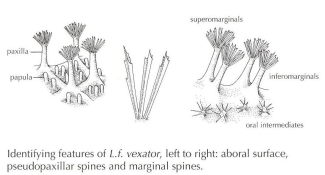Lophaster furcilliger vexator is pastel yellow with orange on the arms; the dark brown pyloric caeca shows through skin of the aboral surface. It has five arms up to 8.2 cm long. The ratio of arm to disc is from 3.3 to 4.4. The aboral surface consists of a coarse meshwork of calcareous skeleton with a stout pseudopaxilla arising at the junction of each mesh. Each pseudopaxilla has 20 or more glassy spinelets with two to four delicate teeth at the tip. The papulae form groups of 2 to 12. Approximately 24 well-spaced conspicuous pseudopaxillae occur along supero- and inferomarginals. The oral interradial area is normally triangular with 8 or 9 pseudopaxillae. Oral intermediates form a single row from the third inferomarginal to the tip of the arm. The adambulacrals are short and wide, the spaces between the plates about equal to the length; each has five furrow spinelets, sometimes reduced to one at the tip of the arm. On the oral surface, they have a transverse series of 2 to 4 longer, more robust spinelets. The mouth plates have 7 or 8 marginal spinelets joined by a web with 7 or 8 suborals along the suture.
Lophaster furcilliger occupies deeper water than L.f. vexator and has a smaller disc, thinner arms and more slender pseudopaxillae. Its arm-to-disc ratio is 4.4. It seems to intergrade with L.f. vexator, which Fisher (1911) suspected was intermediate to the Atlantic species Lophaster furcifer but chose to keep it separate. Grieg (1921) maintains that specimens of L. furcifer in his possession show transitional forms between L. furcilliger vexator and L. furcifer. Although a close relationship among these three forms has been suggested by several authors, no one has yet designated them as the same species.
Characteristics
Similar SpeciesThe only other species in this book with similar surface detail to Lophaster furcilliger vexator is Crossaster papposus, but the colour and number of arms separate them easily.
